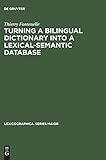Turning a Bilingual Dictionary into a Lexical-Semantic Database / Thierry Fontenelle.
Material type: TextSeries: Lexicographica. Series Maior : Supplementbände zum Internationalen Jahrbuch für Lexikographie ; 79Publisher: Tübingen : Max Niemeyer Verlag, [2014]Copyright date: ©1997Edition: Reprint 2014Description: 1 online resource (328 p.)Content type:
TextSeries: Lexicographica. Series Maior : Supplementbände zum Internationalen Jahrbuch für Lexikographie ; 79Publisher: Tübingen : Max Niemeyer Verlag, [2014]Copyright date: ©1997Edition: Reprint 2014Description: 1 online resource (328 p.)Content type: - 9783484309791
- 9783110920116
- online - DeGruyter
- Issued also in print.
| Item type | Current library | Call number | URL | Status | Notes | Barcode | |
|---|---|---|---|---|---|---|---|
 eBook
eBook
|
Biblioteca "Angelicum" Pont. Univ. S.Tommaso d'Aquino Nuvola online | online - DeGruyter (Browse shelf(Opens below)) | Online access | Not for loan (Accesso limitato) | Accesso per gli utenti autorizzati / Access for authorized users | (dgr)9783110920116 |
Frontmatter -- Table of contents -- Abbreviations -- Mel’čuk’s lexical functions and lexical-semantic relations -- Acknowledgements -- 1. General introduction -- 2. Acquisition of lexical and co-occurrence knowledge: an overview -- 3. A few collocational dictionaries -- 4. Pustejovsky’s Generative Lexicon -- 5. Meaning – Text Theory and the Explanatory Combinatory Dictionary -- 6. Constructing a database from the Collins–Robert Dictionary -- 7. Defining formulae and lexical functions -- 8. A few suggestions towards the creation of additional functions -- 9. Assigning lexical functions: tests and consistency -- 10. A closer look at the lexical function Son -- 11. Noun alternations and sense extensions -- 12. Transitivity alternations -- 13. Metaphors and lexical functions -- 14. Pedagogical applications -- 15. General conclusions -- 16. Appendices -- 17. Résumé -- 18. Zusammenfassung -- 19. Bibliography -- 20. Index
restricted access online access with authorization star
http://purl.org/coar/access_right/c_16ec
This volume addresses the complex problem of the use and exploitation of bilingual lexical resources available in machine-readable form. The reusability of lexical resources has indeed attracted a lot of attention in the past few years but NLP researchers have tended to concentrate mainly on monolingual English learners' dictionaries, somewhat neglecting bilingual dictionaries. The first part of the book describes the construction of a lexical-semantic database from the machine-readable version of the Collins-Robert English-French dictionary and the design of flexible retrieval programs which make it possible to readily extract the collocational and thesauric information it contains. The emphasis is laid on the lexicographical work which was required in order to enrich the database with lexical-semantic information based on Mel'cuk's descriptive apparatus of lexical functions. The second part of the book deals with the use of the database to investigate the structure of the English lexicon, focusing more specifically on the extraction of verbs participating in the causative/inchoative alternation, on the analysis of sound verbs or on the study of the relationship between collocations, lexical functions and metaphors/sense extensions. The pedagogical use of this database of around 70,000 pairs of collocates and semantically-related items is also discussed.
This volume addresses the complex problem of the use and exploitation of bilingual lexical resources available in machine-readable form. The reusability of lexical resources has indeed attracted a lot of attention in the past few years, but NLP researchers have tended to concentrate mainly on monolingual English learners' dictionaries, somewhat neglecting bilingual dictionaries.
Issued also in print.
Mode of access: Internet via World Wide Web.
In English.
Description based on online resource; title from PDF title page (publisher's Web site, viewed 28. Feb 2023)


